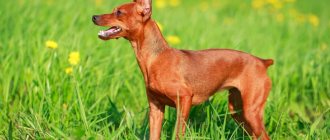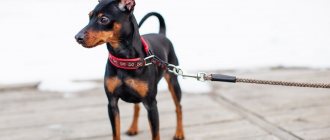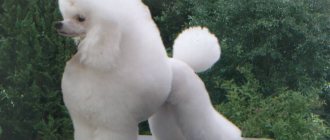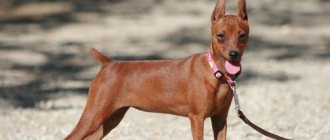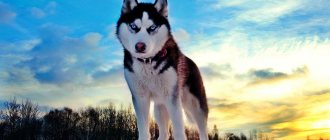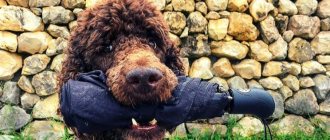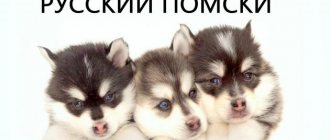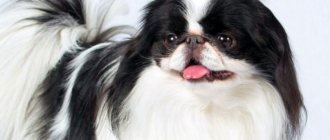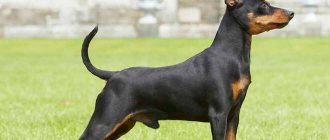Brief history of the breed
Initially, the breed had a different name - Thuringian Pinscher. Dogs bred by Karl Doberman began to be called by his name only after the death of the author. In 1949, the word “pinscher” was removed from the name. The history of the origin of the breed dates back to 1880.
Smart and graceful dog - Doberman Pinscher
Karl Doberman, a resident of the city of Apold, while working as a night policeman, thought that it would be nice to have a well-trained dog as a partner. It was this idea that prompted him to buy additional space and start breeding a suitable breed of dogs. As a result of this work, the German Doberman Pinscher appeared.
It is not known for certain which breeds were used for crossing, but presumably they could have been Rottweilers, Old German Pinschers and Great Danes. The main task was to combine high intelligence, good security qualities and the ability to train in the dog’s character. Judging by the reviews of modern Doberman breeders, the result was achieved.
History of the breed
The ancestor of the Dobermans was a mini-pinscher, which the inspector decided to increase in size. In the process of breeding, not only small Dobermans were involved, but also German and French shepherds, greyhounds and terriers, Rottweilers and setters.
As a result of much work, the result was a powerful large dog similar to its small ancestor. In 1894, after the death of Friedrich, the breed was named after the creator of the Dobermann.
Over the course of 4 decades, they decided to breed albinos whose brown or black fur was replaced with white; it looked very beautiful, but as a result of the gene mutation, the animal began to suffer from numerous diseases, primarily the dog developed problems with the eyes . Albinos are not removed after a bad experience.
Description of the breed
Scottish Setter Gordon: description of the dog breed
The appearance of this dog breed combines grace and power.
Appearance consistent with breed standards
A Doberman's appearance can be described in more detail based on a number of characteristics.
| Height Weight | The height at the withers for males does not exceed 73 cm, and the weight is 45 kg. For females, the height limit at the withers is 67 cm, and the weight limit is 35 kg. |
| Body type | The body structure is proportional and muscular. The back is straight, the chest is pronounced and more developed in the upper part. The length of the body is slightly greater than the height at the withers. The front and rear legs are straight with pronounced muscles. |
| Head | The size of the skull is medium and proportional to the body, the muzzle is wedge-shaped. The forehead is straight and smoothly passes into the nasolabial part. The eyes are oval, brown with a dark iris. |
| Ears, tail | Ears and tail are docked in most cases. In its natural form, the Doberman is fold-eared with a thin tail. After docking, the ears are pointed and erect, the tail is short. |
| Wool | The coat has no undercoat, is smooth and hard. Fur covers the entire body. |
| Color | The norm is black or brown coat color with characteristic brown markings. |
Based on the color of their coat, there are different types of Dobermans: brown and black.
A dog of a lighter shade is a red Doberman. Many people mistake dogs that are similar in appearance to this breed as a separate species and believe that this is a dwarf Doberman. In fact, these little Dobermans are representatives of the miniature pinscher breed.
Important! Only dogs that meet the above parameters can be considered purebred.
Any differences from the norm can affect the dog's character and health.
How not to make a mistake when choosing a puppy
If your preference falls on this breed, you need to learn a few rules when choosing a puppy:
- The puppy is adopted at the age of 9 weeks and older. They must have an initial vaccination and undergo deworming. The breeder must submit a veterinary record, which indicates the name of the procedure and the date of the procedure.
- It is necessary to pay attention to the condition of the skin and mucous membranes. A clean and shiny coat, clear eyes and no mucous discharge from the eyes indicate the puppy’s good condition.
- The weight of a 9 week old puppy ranges from 7 to 9 kg.
- A strong and healthy puppy will come from a litter with 4 or 6 babies, no more.
- Before buying, you need to carefully look at the pet’s habits; active, unafraid and playful puppies are a sign of good health and a balanced psyche.
- Don't be shy about asking to see the puppies' mother. If she is well-groomed, not aggressive, and has a balanced psyche, then there is no need to worry about the offspring.
- The best option is if the parents live outdoors, in an enclosure. Nurseries with cramped enclosures are not the best option for acquiring a new friend. Lack of space makes the puppy timid and fearful. You should pay special attention to this; by buying a cheap puppy, you can buy a playful, clumsy and affectionate pet, which will later grow up to be an aggressive and disobedient dog.
Disqualifying faults
Karelo Finnish Laika: description of the dog breed
Compliance with breed standards is not just a sign of a dog’s elite status. Any physiological deviation from the norm will not only exclude the possibility of participating in exhibitions and competitions, but may lead to difficulties in raising the dog and will increase the likelihood of developing diseases typical of the breed.
These signs include:
- lighter shade of the eyes and iris;
- the presence of white spots or completely white coat color;
- deviation from norms in weight and height;
- waviness of the coat or excess of its length;
- malocclusion or irregularity in the position or number of teeth.
White color is a disqualifying fault
In addition, you should pay attention to the dog’s physique, it doesn’t matter whether it is a brown Doberman or a different color. Dobermans are built very proportionally, and disproportion of body parts is also considered a deviation from the standard.
Doberman, or Doberman pinscher.
This name (new - Doberman, old - Doberman Pinscher) reflects the history of an extraordinary breed. Extraordinary beauty, sharp intelligence, fiery temperament, outstanding service qualities and extreme devotion of the Doberman to its owner - all this has created a huge army of Doberman fanatics. How did he turn out like this? Let's return to history, or rather, to what we know from it. Friedrich Lewis Dobermann (1834-1894), the creator of this breed, lived in Thuringia, in the city of Apolda. Information about his profession is contradictory. Some sources report that he worked as a tax collector, according to others - as a flayer. Be that as it may, while collecting taxes, F.L. Doberman needed protection, and being a dog catcher, he had the opportunity to legally select evil individuals for himself. It seemed to him, however, that it was not enough to keep aggressive guards, the “fawnies” - he dreamed, according to the successor of his life’s work, Otto Göller, to create a new breed, the representatives of which would become large, strong, vicious, sharp, fast, jumping, instinctive, smart dogs , easy to train and beautiful! At the same time, he conceived a dog that could be the dog of one owner. This task seemed overwhelming. However, he managed, in principle, to solve it in just over twenty years. How did this happen? All researchers agree that the history of the breed began in the 70s of the 19th century with a litter of a black and tan, strong and very vicious female of the Old German Pinscher type, bred somewhere on the side with shepherd dogs. From her, F. L. Doberman left himself a bob-tailed puppy - a bitch, which he later repeatedly used as a breeding dog. The Old German Pinscher was perfectly suited for crossbreeding, being distinguished by its small stature in strength, mobility, fearlessness and intelligence. The second ancestor of the Doberman is considered to be the Rottweiler, known at that time as the Metzgerhund, that is, the “butcher’s dog.” Rottweilers were common in Thuringia, where they were used to drive livestock. F. L. Doberman bred crosses of the two original breeds with Beaucerons, who settled in this region after the passage of Napoleon’s army, whose convoys they accompanied. The local population bred Beaucerons in purity, wanting to preserve their excellent performance qualities. These three breeds, which became the basis for the breeding of the Doberman, were in many ways similar: black and tan color, short hair, courage, fearlessness, ability to train - all this made it easier to obtain relatively similar offspring. Among the breeds used for the further “construction” of the Doberman, contemporaries named the Wey Maranera, local shepherd dogs, Great Danes, Greyhounds and Manchester Terriers. F. L. Doberman himself called the dogs of his new breed Thuringian pinschers, from which it followed that he considered the pinscher to be the base breed. The initial type of dogs created by F. L. Doberman over the twenty years of his work was significantly different from what we are used to seeing at the present time. These strong dogs were smaller in stature, stretched out, rough-headed, simple-minded and extremely vicious: according to contemporaries, “it was as if the devil was sitting inside them.” Otto Göller, an associate and fellow countryman of F. L. Doberman, after his death continued to improve the breed, ennobled its appearance and, preserving the special service qualities of these dogs, made them controlled by humans. It was O. Göller who proposed calling the breed Doberman Pinscher in order, on the one hand, to pay tribute to the memory of its creator, and on the other, to indicate its main breed type. This name remained this way until 1949, when, at the suggestion of the German side, who probably wanted to separate themselves from the large group of pinschers and schnauzers, it was decided to shorten the name and henceforth call this breed Doberman. The first National Doberman Club of Germany, created in 1899, was headed by its creator O. Göller, who also became the author of the first breed standard. Already at the end of the 19th and beginning of the 20th centuries, the Doberman Pinscher was actively used by the police, first in Germany and then abroad. Since 1903, the breed has been known in Russia, where it soon earned the reputation of police dog No. 1 thanks to its passion for work and unusually keen sense of smell. However, the harsh Russian climate subsequently forced the short-haired Doberman Pinschers out of police service, and German Shepherds took their place. By the middle of the twentieth century, the Doberman Pinscher turned into a symbol of the ideal embodiment of canine beauty. In 1960, the first modern breed standard was adopted, which corresponds to the image of the Doberman as we are accustomed to seeing it. This is a high-fronted, compact dog with perfect silhouette lines, short, rather high-legged and large (up to 70 cm at the withers), with a slender neck and a chiselled profile of a dry head. Proud posture, impetuous movements, strong and passionate character. Lacquered wool, black or brown with rusty marks. It is extremely devoted to its owner and his family and, when guarding them, poses a serious danger due to its lightning-fast reaction, powerful grip and solid build, which is deceptively masked by its overall elegance. However, German breeders are gradually beginning to modify the type and appearance of the Doberman. And as a result, in 1994, a new standard was adopted, which makes changes to the size of the Doberman, to its pattern and even to its origin. Only the Rottweiler and the Black and Tan Shepherd are now considered to be the ancestors of the Doberman. This Doberman is becoming larger (up to 72 cm at the withers), although, according to the text of the standard, it should still be of “average height.” Its format is extended to 105 cm for males and to 110 cm for females. Bitches are allowed to be stretched out at the waist for reasons of "space needed for nursing puppies." The Doberman's head is no longer required to be dry, and its profile no longer has to correspond to the shape of a blunt wedge. The requirement for parallel lines of the skull and the back of the nose disappears, but the condition of flattened cheekbones appears. These changes have led to the emergence of a “different” Doberman in droves. Here are its typical features. Today's Doberman has become larger, stronger, more massive and “deep”, but for the most part it has ceased to be short and compact. His head became coarser in profile, his forehead became roundish, the transition became sharp, his muzzle became not long enough. The lower back has lengthened and lost its elasticity. The depth of the chest definitely increased, but at the same time the chest became significantly narrower and the ribs flatter. The topline in movement lost its integrity, the back lost its strength, and a high rear appeared in movement. The anterior chest convexity increased significantly, but the shoulder angle did not improve. The straightening of the shoulder angle in parallel with the cultivation of exaggerated angles of the hind limbs caused an imbalance in movement, etc. This does not mean that today there are no Dobermanns capable of arousing the admiration of connoisseurs - fortunately, such dogs exist, only their number is small. I provided a detailed commentary on the changes in my book “FCI Standards and Comments”. Here I will briefly explain my view of things. The lengthening of the format of the modern Doberman was not accidental. The type of short and wide-bodied pinscher was forced out of the Doberman phenotype, just as the word “pinscher” disappeared from the name of the breed. But the intrabreed types of Rottweiler and Shepherd began to dominate, with their characteristic pros and cons. In addition, the widespread misconception that a longer loin in bitches is the norm due to the need for more space for raising puppies played a role in the lengthening of the format and loss of compactness of the Doberman. This statement, as well as its argumentation, does not stand up to criticism under the pressure of a large number of “short” breeds, where bitches with a short loin cope well with this role. It is also important to know that lower back length is not a gender-linked trait. And bitches with a long loin will give birth to puppies of both sexes with a long loin, and more males with this trait will be born than females, since the typical inheritance pattern is “sons take after their mother, and daughters take after their father.” Thus, lengthening the format was inevitable, and the authors of the standard only had to subsume this change into a new norm of the standard. The loss of compactness has also become inevitable, since compactness is identical to a short waist. The long loin damaged the strength of the back and the integrity of the topline in movement, which increased energy losses during the transmission of motor impulses from the hind limbs to the forelimbs and increased the fatigue of the Doberman. The increase in hind leg angles went the wrong way by lengthening the tibia rather than the femur. The resulting shortening of the femur resulted in a high rear end in the process of transmitting motor impulses to the forelimbs. The Doberman's head has ceased to serve as a measure of his nobility - the nobility of today's representative of this breed is determined primarily by the shape of his neck. It is also no coincidence that the head itself has lost the parallelism of the profile lines, since parallelism between the rounded forehead and the straight back of the nose is impossible. The change in its shape was a consequence of the flattening of the cheekbones - the head seemed to be squeezed from the sides. However, the ratio of the girths of the skull and muzzle is constant, and it is clear that with such compression the skull grew in height, lost its flatness, and the transition to the muzzle deepened. Against the background of this heavier skull, the previous depth of the muzzle began to look insufficient, and this caused emphasis on the development of the chin and a more massive muzzle. However, the most important change affected the Doberman's lifespan - it was reduced by at least half. Nowadays, Dobermans typically die at six years of age, and sometimes even during puppyhood. And the cause of their early death was heart failure - cardiomyopathy (CM). Soviet-bred Dobermanns did not suffer from CMP, lived long and looked different in appearance: they were taller-legged and broader-chested. Currently, research is being conducted to identify correlations between the ICM and the biometric features of the Doberman Pinscher's build. If successful, this will mean that the key has been found to identify dogs at risk, treat them at an early stage of the disease, when it is not yet diagnosed by conventional methods, and most importantly, to select breeding sires free from CMP. It is hoped that the results of the research will help the Doberman regain his longevity so that he can continue his work as a first-class service dog without risk to health. Doberman - problem areas Today's Doberman has become larger, stronger, more massive and “deep”, but for the most part it has ceased to be short and compact. His head became coarser in profile, his forehead became roundish, the transition became sharp, his muzzle became not long enough. The lower back has lengthened and lost its elasticity. The depth of the chest has definitely increased, but at the same time it has become significantly narrower, and the ribs are flatter. The topline in movement lost its integrity, the back lost its strength, and a high rear appeared in movement. The anterior chest convexity increased significantly, but the shoulder angle did not improve. Straightening the shoulder angle in parallel with cultivating exaggerated hind limb angles caused an imbalance in movement. The lower back has lengthened and lost its elasticity. The increase in hind leg angles went the wrong way by lengthening the tibia rather than the femur. His head became coarser in profile, his forehead became roundish, the transition became sharp, his muzzle became not long enough. The depth of the chest has definitely increased, but at the same time it has become significantly narrower, and the ribs are flatter.
Yerusalimsky Evgeniy
magazine “My Friend the Dog” number 9, 2011.
Character and behavioral characteristics
Many people believe that the Doberman Pinscher is a dangerous and aggressive breed. This can only become true if the dog’s owner does not engage in training, education and socialization of his pet.
Parson Russell Terrier: description of the dog breed
The breed was bred to protect the owner and his property. The Doberman fully meets these requirements. He is devoted to his master and intuitively senses a threat. At the slightest danger, this brave dog will, without hesitation, decide to defend himself.
Many breeders note that Dobermans have a high ability to train. In addition, they not only learn commands quickly, but also remember them. This also simplifies raising a dog, because having once learned the rules of behavior, it will unquestioningly follow them all its life.
Attention! Under no circumstances should you apply harsh training methods to Dobermans.
The dog can become aggressive and unpredictable.
Training
The breed is easy to train and quickly comes into contact with the owner. It shows aggression only if it feels that its owner is in danger. In general, the dog is reserved, has a sharp mind, is attentive and fearless. He also gets along well with children.
During training, you need to know the nuances of training:
- Raising your voice and taking harsh measures is not allowed.
- A puppy begins to be raised at 3 months of age.
- You cannot practice the grip exercise before changing teeth.
- After a correctly executed command, encouragement and affection are a must.
- Before guard training, the dog must clearly follow all obedience commands.
Early socialization
In order for a dog to grow up adapted to the world, it is necessary to socialize it from a very early age. This involves a number of actions:
- walking in crowded places;
- meeting other dogs;
- communication with strangers;
- getting used to transport.
Meet strangers at an early age
You should not protect your pet from meeting other dogs while walking. He should feel calm and confident when he sees his relatives. If the owner tries to quickly get the dog away from the unfamiliar dog, the dog may begin to perceive any stranger as a danger. This will lead to the development of aggression towards all unfamiliar animals.
Important! Considering the developed protective qualities of Doberman Pinschers, these dogs need to be socialized from a very early age.
Similar breeds
In appearance, but not in size, a breed similar to the Doberman is the German Doberman. It is believed that it was from this breed that Mr. Dobermann took an example for developing a new breed. In appearance it is closer to the American one, but the coloring is close to the European one. The German relative is medium in size, ideal for apartment living. There is also an even smaller breed - the miniature pinscher, or mini Doberman. This breed is absolutely identical to its brothers, and the main difference is only the size.
Reference . This breed, as well as the German Doberman and Miniature Pinscher, are very intelligent and easy to train. They are hunting dogs; with proper training, they can easily pick up a person’s scent and therefore often serve in law enforcement agencies.
Education and training
The Doberman Pinscher breed requires a serious approach to education and training. Only with proper training can you grow your pet into a loyal guard and well-mannered friend.
Upbringing
Immediately after the puppy has found its new home, you need to start raising it. First of all, he must learn the rules of behavior in the new home. These include a number of daily activities:
- getting ready for a walk;
- feeding;
- washing paws;
Attention! Owners usually have difficulty teaching their dog to ask to go to the toilet or wait until they go for a walk. This moment is especially difficult for beginners. But don’t be disappointed right away - a little patience and everything will work out.
It is very important to accustom your pet to a routine of walking and feeding from a very early age. It is advisable to do this at the same time, since any dog needs a routine, and especially a guard dog - a Doberman. A properly drawn up plan of daily activities will make it easier for both the owner and his pet to live together.
The most important thing is to immediately let the Doberman know who is the boss. This does not in any way imply the use of force. You need to become a leader and earn authority in the eyes of the dog. Only then will he grow up obedient and well-mannered.
Training
You need to start learning the simplest and most necessary commands from a very early age. At home, you can learn the commands “sit”, “lie down”, “place”. During a walk, it is better to train the commands “come to me” and “nearby”, but if the puppy is very distracted, you can first practice them at home.
The nature of training depends on what role the owner assigns to the dog. If she is to become a faithful companion and family member, it is enough to complete a general training course. To further develop security or service qualities, it is better to contact specialists to undergo a special training course.
Métis
Mixed breeds are puppies born from representatives of two different purebred dogs . The breeding of mestizos sometimes leads to the emergence of new breeds, and interbreeding is actively used by breeders. However, this can lead to both good and bad results, and inexperienced people should not experiment with animal genetics.
Rottweiler mix
Mixed breeds are stockier, have the same coloring and are very similar in appearance to both Rottweilers and Doberman Pinschers. Traits are inherited as follows:
- Puppies get their body exterior mainly from Doberman Pinschers;
- the exterior of the head is from Rottweilers.
Character traits are inherited equally from both parents, but puppies require training. In general, they make brave guard animals .
With a shepherd
There is a separate name for puppies born from a Doberman and a German Shepherd - Berger. This mixture of blood produces good guard dogs that require careful training, otherwise they will grow up irritable and very aggressive. In childhood, these are playful puppies, prone to biting, which must be stopped, since the animal quickly loses control over the force of the bite.
In appearance, Bergers resemble a Doberman, inheriting the color of a shepherd dog . These are tall slender dogs with a pointed muzzle and high erect ears. The limbs are long and powerful, with wide paws.
With a pit bull
A very dangerous mixture of blood, since the puppies inherit the famous death grip from the pit bull. The color and structure of the muzzle are very similar to those of pit bulls, and the slender legs and long body are inherited from the second parent. Sometimes puppies get the coloring characteristic of Doberman Pinschers.
These mixed breeds make good guard dogs , but puppies need training to avoid excessive activity and aggression. They have their own name - Canis panther.
With a mongrel
It is very difficult to guess the character and appearance of a Doberman mixed breed with mongrels - it all depends on the second parent, his blood, appearance and character. In general, animals usually turn out to be strong, with good immunity, and are distinguished by loyalty and good obedience if properly raised. Externally, the animals are usually tall and strong.
Other famous hybrids
- A cross between a Doberman and a black Great Dane - in appearance the dogs are absolutely black, tall, with an exterior closer to a Doberman, but very tall.
- Doberman and Labrador mixes are large dogs with the appearance of a Doberman and the muzzle characteristic of a Labrador.
- A cross with a Siberian Husky, they are short, powerful animals with short hair and the characteristic color of a Doberman.
Features of care
For a dog to be healthy and active, it needs care. As for the Doberman, the list of necessary measures includes:
- cleaning the ears and nose;
- treatment against parasites;
- timely vaccination.
Grooming for this breed is minimal. There is no need to bathe your dog often; 2-3 baths a year are enough. After a walk, the wool can simply be wiped with a damp towel.
Ear cropping and care
Compliance with breed standards requires a procedure such as ear cropping.
It is not necessary to crop your ears
Veterinarians disagree on the most appropriate age for this procedure. Terms vary from 1 to 6 months. Carrying out the procedure later is painful for the animal.
Important! Cupping is prohibited in some countries.
The operation is performed in a veterinary clinic. At the end of it, the ears are fixed in a certain way and bandaged. Subsequent care at home consists of treating the seams with disinfectants. It is also necessary to limit the dog’s access to the ears; it is better to put a special collar on the animal. On the 10th day after surgery, the sutures are removed.
Care and maintenance
The breed is clean and tolerates regular bathing. He does not like to clean his ears: the pet will have to be firmly restrained for the procedure.
Caring for a short, smooth coat does not cause much trouble: the dog is brushed 1-2 times a week, using a brush or mitten for combing.
You need to walk your German Pinscher twice a day: morning and evening hour-long walks will help your pet release pent-up energy. In the absence of energetic pastime in the fresh air, the dog will begin to “smoke” at home.
A nutritious, balanced diet and 24-hour access to fresh drinking water are recommended.
The average life expectancy of a German Pinscher is 15 – 18 years.
Food and menu features
The Doberman is a large and active dog. She needs a balanced diet, which should include a number of specific foods.
| Meat | Meat should make up at least 50% of the diet. The menu includes beef or turkey, you can give chicken fillet. A fatty product like pork is prohibited. |
| By-products | Only beef by-products are produced, which are pre-heat-treated. |
| Eggs | It is better to give raw, mixing into food. |
| Dairy | Cottage cheese or kefir are included in the diet as a source of calcium. Sometimes you can give low-fat cheese in small quantities. |
| Cereals | Buckwheat, rice and oatmeal are suitable. Barley and barley are very undesirable. |
| Vegetables fruits | You can include almost all vegetables in your diet, except potatoes and legumes. An exception may be those to which the dog is allergic. Fruits such as grapes and citrus fruits are not recommended (allergies are possible). |
Attention! Your dog should be taught to eat vegetables and fruits from childhood. Otherwise, she will refuse to eat them and will need additional vitamin supplements.
When creating a menu, you should take into account your pet’s tastes and select a list of products taking into account his preferences. Water should always be fresh and freely available.
If you decide to feed your dog with ready-made food, then it must be at least premium. Proper nutrition for a dog is the key to its health and long life.
Puppy diet
Feeding puppies must be taken especially responsibly. There are several important points to consider.
- For full development, they need a weekly calcium intake; cottage cheese is a suitable source.
- It is better to first pour boiling water over the meat or boil it.
- By-products are introduced into the diet gradually.
- Fruits and vegetables begin to be given from 3-4 months in small quantities.
Puppies should be fed at least 4-5 times a day, gradually reducing the frequency of meals. It is better to give filtered water and change it daily.
Character
The German Pinscher is a playful and active dog.
Pinschers are dogs with an energetic temperament. They prefer an active pastime and can accompany their owner on long trips or walks. The Pinscher tends to become attached to humans. But the owner must defend his authority, since pets strive for leadership. The owner will need time and patience to establish a partnership with the dog.
Please note that you cannot adhere to too strict a line of behavior. Pinschers will not tolerate rude treatment and may respond with aggression. They have a developed hunting instinct. Therefore, it is not advisable to keep these dogs together with cats or rodents. The Pinscher easily establishes contact with other dogs.
This breed has a good-natured and balanced disposition and is favorable towards children. Pinschers are smart and clean. Not prone to empty barking. These dogs are considered one of the most emotionally open, they are sure to share both joyful and sad experiences with you.
Important! Pinschers are wary of strangers and can be aggressive.
Arrangement of a spacious enclosure
Dobermans are recommended to be placed in private homes. It is not always convenient to keep such a large animal in an apartment; moreover, the owner often does not have the opportunity or time to take the dog for long and active walks.
A spacious enclosure is suitable as a place to keep a dog in the summer. It must have a strong metal fence and a plank floor. Within the enclosure, it is necessary to place a booth in which the pet can sleep at night or rest during the day. You can keep a Doberman in such an enclosure only in the warm season, because it is not long-haired and has no undercoat.
Important! Dobermans are very attached to their owner and have an innate need to protect him. It is better to surround the yard with a secure fence and keep the dog free-range.
Dog care
Features of living in an apartment
Pinscher needs long walks outside
The German Pinscher is well suited for apartment living. The dog sheds little, so there will be no need for frequent cleaning. The Pinscher has a friendly disposition. But if small children live in the apartment, leaving them alone with the dog is not recommended.
The Pinscher's active temperament should also be taken into account. He needs regular physical activity. In their absence, the dog will get bored and begin to look for entertainment, making a mess in the apartment. To avoid such situations, leave toys for your pet when leaving home. The pinscher prefers to rest on the owner's bed, but it can also be trained to a separate place.
Hygiene
Pinscher is combed with a rubber glove
The Pinscher is known for its cleanliness. Shedding is moderate. Therefore, it is enough to brush your dog once a week with a rubber glove to remove dead hair. Movements are carried out in the direction of growth of the cover, as well as against it.
The dog only needs a bath if it gets dirty. To do this, use special shampoos designed for smooth-haired breeds: Gamma or Elite. To make the cover shiny, wipe it with a napkin with 3-5 drops of burdock oil.
Examine your pet's eyes every day and, if necessary, clean them with a cotton pad moistened with clean water. This requirement also applies to the ears. Inspect weekly.
Important! If redness in the ears or an unpleasant odor occurs, contact your veterinarian.
You also need to take care of your pet's teeth. To keep them snow-white, clean them 2-3 times a week using a special paste (Trixie, Beaphar Toothpaste) and a brush for dogs. Trim your pet's nails with a nail clipper once a month.
Nutrition rules
The majority of your Pinscher's diet should consist of animal products. As a supplement, the dog should be given cereals and vegetables. The dog's body digests meat best. It should be half the animal’s daily diet. Pinscher needs to be given beef, chicken, goat meat. Pork should be avoided as it is too fatty for dogs.
The pinscher should also receive:
- sea fish;
- oatmeal, buckwheat, millet, barley, pearl barley;
- greens, carrots, beets, zucchini, tomatoes;
- kefir, cottage cheese, fermented baked milk;
- boiled eggs.
To determine the right amount of food, you should watch your dog while feeding. If your pet licks the bowl, this indicates not enough food. Experts advise calculating the norm based on the weight of the animal. For 1 kg of weight, 15 g of carbohydrates, 2 g of fat, 4 g of protein are required. Also provide your pet with unlimited access to water. A dog after 6 months is fed 2 times a day, from 4 to 6 months - 4 times a day, from 2 to 4 months - 5 times, up to 2 months - 6 times.
In addition to natural products, the Pinscher can also be given dry mixtures. But you should give preference to premium food: ROYAL CANIN, Miqhty Dog.
Walk
The Pinscher requires long walks. They love to run, jump, play with a stick, and participate in bicycle rides. You need to walk your pinscher 2 times a day for 1–2 hours. Let him off the leash only after he responds well to your call. The Pinscher has a hunting instinct, so on the street it can follow a scent and get out of control.
Pregnancy and childbirth
You need to help your dog during childbirth
The duration of a female's pregnancy is 56–62 days. Depending on the individual characteristics of the dog’s body, birth may occur on days 55–72. It is worth paying attention to the following features:
- During the first 3 weeks, there is no need to make changes to your pet's diet or lifestyle. However, after this period, limit active games and jumping.
- Switch your dog to three meals a day. From 4 weeks, increase the amount of food by 30%, and from 6 weeks, give the dog 2 times more food.
- In the second month, signs of pregnancy become noticeable: the female’s mammary glands and abdomen become enlarged. At 6 weeks you can feel the puppies moving.
- From day 56, regularly measure your dog's temperature. A drop in readings to 37°C indicates that labor is approaching.
- Also, the dog’s mammary glands swell, the stomach drops, and the dog’s behavior becomes restless.
Prepare a box for the puppies, napkins, a heating pad, scissors, silk thread, and diapers.
The onset of labor is indicated by irregular contractions of the uterus. At this time, the dog shows anxiety, looks for a place, and may approach the owner and whine. You need to place your pet on a pre-prepared bedding and stay next to her throughout the entire birth process.
Over time, the intervals between contractions decrease. Attempts begin. The interval between the breaking of water and the birth of the puppy can be 3 hours. But if after this time the baby does not appear, you need to contact a veterinarian.
When a baby is born in the amniotic sac, it needs to be torn. Cut the umbilical cord, 2 cm away from the baby's tummy. If there is bleeding, bandage it with thread. Wipe the puppy with a napkin and give it to the dog. When the second baby arrives, place the first one in a box with a heating pad.
Important! Make sure that the number of afterbirths corresponds to the number of puppies.
How to properly raise and train a pet?
Pinschers strive for dominance. Therefore, you need to start training immediately after the puppy appears in the house. He is taught to respond to his own name, walk on a leash, and rest in his own place. Pinscher training begins at 4 months. The Pinscher is distinguished by its developed intelligence, thanks to which it easily assimilates various commands. For example, “Place!”, “Come to me!”, “You can’t!”, “Nearby!”.
Important! When training, the owner must defend his authority, since the pinscher will make attempts to take the position of leader.
Important Rules
The Pinscher is a smooth-haired breed. In the cold season, you need to walk him in insulated overalls. When choosing clothes, make sure that they do not restrict the dog’s movement and do not cause him discomfort. But pinschers tolerate heat well. High temperature does not affect the dog's well-being.
Active walks with physical activity by age
From a very early age, the Doberman needs long walks. It is better to think in advance about what to do with your dog at this time. The best option would be to combine mental and physical stress.
Walks should be active
While walking your dog, you can learn new tricks in a playful way or practice obedience commands. From time to time it is advisable to take your pet to the least crowded places to give her the opportunity to run around.
Dobermans show good performance in various dog sports, such as agility. If you start exercising from childhood, your pet will be in excellent physical shape until old age. Even older dogs need minimal physical activity, but they should not be overloaded.
How to choose a puppy?
Puppies should be active, playful and have a good appetite.
When choosing, you need to take into account the temperament and physical characteristics of the animal. The head should be oval, the legs should be straight, the back should be level, and the ears should be triangular. Make sure the eyes are clean and free of discharge. A healthy puppy's coat is smooth and has a glossy shine.
Observe the feeding process. If puppies actively absorb food, this indicates that the dogs are in good health. Also check the animal’s veterinary passport, which should contain information about the pet’s vaccination and deworming.
Pros and cons of the breed
Before deciding on a breed, you should evaluate all its advantages and disadvantages.
The advantages include the following qualities of Dobermans:
- high learning ability;
- excellent security qualities;
- ability to get along with other animals;
- ease of care.
It is difficult to find faults in this breed. These include rather the consequences of improper upbringing or maintenance.
Important! The Doberman needs training and long walks. If these rules are not followed, problems may arise.
Health and major diseases, life expectancy
Like other service dogs, Dobermans are in good health.
But some representatives of this breed may be predisposed to the following diseases:
- Cardiomyopathy.
- Digestive disorder.
- Gastric volvulus.
- Blood clotting disorder (F. von Willebrand-Jurgens syndrome).
- Hypothyroidism.
- Wobbler's syndrome (slipping of the cervical vertebrae).
- Epilepsy.
- Intermittent claudication.
- Fibrous dysplasia.
Some Dobermans, especially the blue and Isabella varieties, may be prone to allergies.
Their average life expectancy .
Breed standard
The German Pinscher is a strong, muscular, agile medium-sized dog with a huge amount of energy. The height of adult individuals is 45-50 cm , weight is about 14-20 kg .
An elongated head rests on a long, muscular, beautifully curved neck. The skull is strong, the occipital protuberance is almost invisible. The forehead is flat. The ears are triangular in shape and set high. Hanging on cartilage.
Dark oval-shaped eyes.
The muzzle is wedge-shaped. The bridge of the nose is straight. The nose is quite large and black.
The jaws are powerful. The bite is completely scissor. The lips are dark and tightly fitting.
The croup is slightly rounded. The loin is deep and strong. The back is short. The underline is gently curved, the belly is slightly tucked. The chest is quite wide, oval in shape. The bell of the sternum is clearly visible.
The tail has a saber or crescent shape.
The limbs are smooth, strong, and muscular. The front legs are rounded. The hind ones are longer than the front ones. Fingers in a ball.
The walk is a typical trot.
The skin is tight-fitting on all parts of the body.
The coat of the German Pinscher is short, smooth, and close-lying.
Color black and tan. Glowing red shades is allowed.
Nutrition for puppy and adult dog
Your pet's food should contain a sufficient amount of fiber, vitamins, proteins and carbohydrates. The basis of nutrition should be meat products, various cereals, vegetables, fruits, and dairy products.
From 3-4 weeks, the puppy should be accustomed to natural food, which consists of the following products:
- raw chicken necks and wings;
- offal (liver, heart), bone and any minced meat;
- chopped raw vegetables, fruits;
- large bones for training teeth and jaw;
- vitamins B, C, E;
- eggs;
- yogurt or kefir;
- flax oil;
- fish fat;
- minced garlic.
Dog on a walk
Cottage cheese, fish, and honey are periodically added to the diet. The daily food intake is 5-10% of the puppy’s current weight. The health, life expectancy, formation of joints and skeleton of the baby depend on a properly formulated diet.
An adult Pinscher should be fed at intervals so that the stomach has time to digest the food. Constant access to food contributes to loss of appetite, poor bowel function, obesity, and constipation. In order to activate metabolism and empty the intestines, it is recommended to arrange a fasting day once a week.
Additional Information! When feeding fish, it must be boiled until the bones are completely softened, after removing the gills and clearing the insides of the black film.
